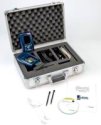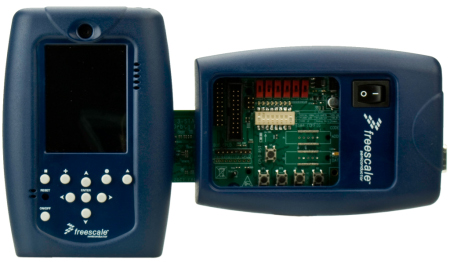Linux development platform takes on license compliance
May 21, 2009 — by Eric Brown — from the LinuxDevices Archive — 4 views Embedded Alley has upgraded its “Development System for Linux” with tools to create software Bills of Materials, track open source components, trace binary sources, and help OEMs comply with open source license obligations. The new platform also adds support for the Freescale i.MX31 PDK (pictured).
Embedded Alley has upgraded its “Development System for Linux” with tools to create software Bills of Materials, track open source components, trace binary sources, and help OEMs comply with open source license obligations. The new platform also adds support for the Freescale i.MX31 PDK (pictured).
(Click for larger view of Freescale's i.MX31 PDK)
EA's tracking system for open source licensing compliance is claimed to be a first for a Linux development platform. The tracking tools reflect the growing cost of license compliance for OEMs, as well as the frustration developers have with hunting down sources and licensing different components used in open source projects.
“Device manufacturers are using more and more open source packages, and with the number of stacks proliferating, each with different licensing, it becomes more challenging to track,” said EA's COO, Matthew Locke, in an interview, “There's a need for a greater level of sophistication of these compliance tools, helping people through production and beyond, and helping OEMs comply with licensing obligations. We're combining development tools with best practices.”
The focus on component tracking and licensing appears to be part of a trend in Linux development platforms. With key technological components now in place, the platforms are increasingly focusing on procedural and supply chain issues aimed at reducing development time. For example, the upcoming MontaVista Linux 6 will offer different versions based on various semiconductor distributions, and it provides a new build platform and content server for keeping track of open source components. Timesys has also focused on tracking issues with its DIY-oriented LinuxLink 3.0 subscription service. (See farther below for more on the new license compliance features, as well as additional comments from Locke.)
EA's Development Platform for Linux
Linux consultant and services firm Embedded Alley (EA) announced its “Embedded Alley Development System for Linux-based Devices” in December. The Development System is billed as a happy medium between commercial off-the-shelf (COTS) Linux toolkits — which EA notes often lock developers into outdated or unwanted components and limit interoperability — and DIY or RYO (roll-your-own) development models, which can prove time-consuming.
The Development Platform formalizes and adds to the services and tools EA had provided customers in a software/services package and software development kits (SDKs) that support ARM and MIPS platforms. The Development Platform is aimed at board-level port, driver, and application development, and includes open-source software, cross compilers, libraries, debuggers, prepared file system images, product-specific supporting libraries, and an Eclipse IDE (integrated development environment).
Hosted on Ubuntu Linux workstations, the Development System provides stable, current versions of the Linux kernel, libraries, tools, and utilities derived from open source project repositories, says EA. OEMs can then configure specific versions of the Linux kernel, patches, and other software and use the Development System to perform dependency and compatibility checks across components. The system is said to offer the flexibility of letting customers integrate new versions of existing components or add entirely new software and tools. The company also offers services around the platform, and recently added a support portal.
The Development System will soon be offered in a version that supports Android development on the MIPS-based RMI Au1250 processor. Due to arrive in the coming weeks, the new version appears to be the first port of the Google-sponsored Android stack to the MIPS platform, and the first to target the general embedded market, including industrial devices, in addition to consumer electronics.
License to confuse
Because EA's Development System for Linux is an open-ended system that enables developers to integrate code from EA, other project repositories, semiconductor companies, or systems suppliers, the new tracking and compliance tools are all the more necessary. As EA puts it, by offering “freedom of choice” and “not locking developers into a single supply chain, version, or build methodology,” new challenges arise. Not only do OEMs need to track the origin, version, and licensing of project code, says EA, but developers need to document code choices and build options used to create deployment images, both for license compliance and reproducibility.
The Embedded Alley Development System claims to meet these needs with new features including:
- Software BoM creation — Develops Bill of Materials (BoM) lists by documenting packages, versions, licenses, upstream source, patches, and dependencies for both development and production builds
- License Auditing — Flags open source software (OSS) licenses and highlights compliance obligations to match OEM-specified policies
- Source Package Creation — Builds device/project sources and creates source packages tailored to meet licensing disclosure requirements
- Traceability — Supports tracking and verification of matched sources and binaries for redistribution, license compliance, maintenance, and end-product customer support
 Matthew Locke |
The new tools ease the process of revisiting a project to spin off new versions and upgrades, said EA's Locke (pictured). “It makes development more reproducible,” he said. “You can now document how you did the build and what went into it. It offers a full list of everything in a flash image, so you can understand the dependencies. Now if you build three or four versions, you can trace back from the binary to the source package and make sure it is the exact source that matches the binaries. It offers full traceability through the entire lifecycle.”
The key benefit, however, is the ability to identify potential licensing issues. OEMs often spend a lot of money hiring compliance officers or purchasing third-party auditing tools to enforce corporate licensing policies, as well as avoid friction, bad publicity, and potentially, lawsuits. “Most companies want to do the right thing and they don't have the tools to do it,” said Locke. “They often don't understand all the implications of using open source.”
The licensing tools flag different open source licenses and then compare them against OEM policies, explained Locke. “The license auditing feature will warn you if you're linking to something that violates a company policy,” he said.
Litigation over open source violations appears to be on the rise. After GPL-Violations.org won several GPL cases in Germany, including a successful suit against Skype, the Software Freedom Law Center (SFLC) has racked up one GPL settlement after another over the last two years on behalf of the developers of BusyBox in the U.S.. Even Verizon settled with the SFLC when it was discovered that Actiontec's MI424WR wireless router, used by Verizon's FiOS customers, violated the GPL.
In December, the SFLC sued Cisco over a similar GPL violation regarding its Linksys division, this time on behalf of the Free Software Foundation (FSF). Yesterday, Cisco agreed to settle with the FSF, and has vowed to be a good GPL citizen going forward. The SFLC recently published a GPL compliance guide to help companies stay compliant with open source licensing.

Left to right: Personality Module (with CPU Module embedded) and Debug Module
EA adds Freescale to the i.MX
The other major new feature in the EA Development System is the addition of support for Freescale Semiconductor's multi-functional ARM11-based i.MX31 system-on-chip (SoC). The support is specifically offered for Freescale's product development kit (PDK) for the SoC (pictured at top and directly above). Freescale started shipping the kit last June in a package that includes a CPU module, a “Personality” (peripherals) module, a debugging device, and board support packages (BSPs) for either Linux or Windows CE.
The i.MX31 itself first shipped in 2005. Based on an ARM1136JF-S core and clocked from 532MHz to 665MHz, the SoC continues to be popular in a variety of embedded applications including consumer, automotive, and industrial markets.
Stated Ken Obuszewski, product management director for Freescale's Multimedia Applications Division, “Embedded Alley provides a straight path to market by combining stable open source distributions and consulting practices that touch all phases of OEM product life cycles.”
Stated Matt Porter, Embedded Alley chief architect, “Our recent work in the mainline ARM Linux source tree enables our customers, and the open source community at large, to get the most out of i.MX31 silicon, software and services.”
Availability
The Embedded Alley Development System for Linux with i.MX31 support and new license compliance tools, is available immediately, says EA.
This article was originally published on LinuxDevices.com and has been donated to the open source community by QuinStreet Inc. Please visit LinuxToday.com for up-to-date news and articles about Linux and open source.